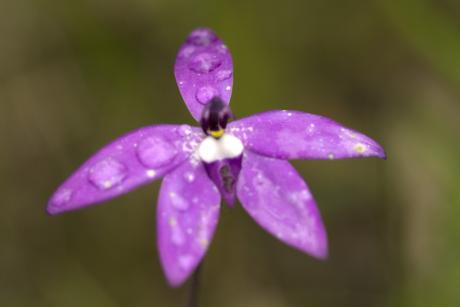Wild Flower Walk - September 2016
 It was nearly a fine day when we met in Narrandera to go orchid hunting with Nella, who has entered all the best spots into her GPS so she can actually find them again next year. We began with a quick little drive down the Newell Highway to view the floodwater, which was quite impressive and then set off towards the hills. Orchids like stony ridges because the drainage is excellent not because it is usually dry. In this very wet year there were hundreds of tiny spider orchids in spots where we saw just a dozen last year. It was hard to walk without treading on exquisite tiny flowers.
It was nearly a fine day when we met in Narrandera to go orchid hunting with Nella, who has entered all the best spots into her GPS so she can actually find them again next year. We began with a quick little drive down the Newell Highway to view the floodwater, which was quite impressive and then set off towards the hills. Orchids like stony ridges because the drainage is excellent not because it is usually dry. In this very wet year there were hundreds of tiny spider orchids in spots where we saw just a dozen last year. It was hard to walk without treading on exquisite tiny flowers.
As well as spider orchids there were still a few donkey orchids, greenhoods and pink fingers to be seen. Another site had a brilliant display of waxlips in just the best shade of blue. Another result of the wet year was a proliferation of Drosera – sundews. Many were still a circle of sticky fly traps, while others had already put up a flower stalk. Bulbine lilies buds were scattered through the bush and in one little spot they were in flower producing their own patch of sunshine.
The small stand of Yarran Acacia homalophylla near the road down to Rocky Waterholes Boat Ramp is always worth a glance because it is quite rare in this area. On Sunday there were several patches of Darling Pea (Swainsona species) flowering nearby, as this pea likes to live in communities with various types of Acacia (from “Plants of Western NSW”).
Thanks, Nella. It was a lovely and very worthwhile morning.
Betty Bradney
Why are some orchids hard to see?
We generally think of flowers as brightly coloured objects attracting bees and birds, but there are other ways of luring pollinators. Orchids like the spider, gnat and mosquito types use mimicry as lures. They emit the specific odorous chemicals (pheromones) that particular female insects emit to attract a mate. The males are extremely sensitive to the right chemicals, only a few molecules is enough to trigger a reaction. Once close to the flower the poor male sees the shape of a female and tries to mate.
Orchids, like lilies, survive from year to year by producing bulbs safely tucked underground and out of sight of the many herbivores hoping for an easy meal. Relying on reproducing solely by seeds is extremely risky for orchids. Their seeds are small lacking much of the food store most other flowering plants have to help the new seedling establish. In addition orchids are totally reliant on mycorrhizal fungi for growth, and the fungus only associates with roots. It cannot travel with the seed. Consequently any germinating seed needs to be in close proximity to the right fungus to survive.
Having nutritious bulbs it makes sense not to advertise that they are there. Colourful flowers or even decent vegetative growth is easily spotted. Hence these particular orchids produce flowers sufficient to attract their pollinators which likewise have to be obscure to predators. Often leaves are only produced at non-flowering times or at least last only long enough to produce the flower and replenish the bulb for next years. It is safer to be cryptic.
Eric Whiting
